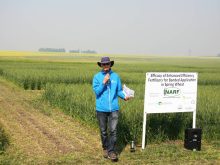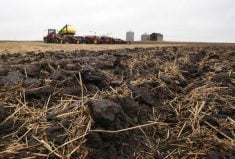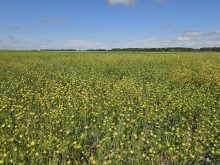MANITOBA
SOUTHWEST
Good quality hay
Scattered showers, a day of grey skies and patches of rain gave crops a boost.
Most cereals are heading and the earliest crops are starting to turn. Some fusarium has appeared, but no other major disease problems are noted.
Canola is ending the bloom except for the last-planted crops. Peas are turning and harvest will be soon.
Winter wheat and fall rye are turning and the combines should be running in a few days.
Read Also

Genesis Fertilizers seeks government funding
Genesis Fertilizers is actively seeking funding from government and a strategic partner. The company dispelled a rumour that DL E&C has abandoned the project.
Hay has been good for both yield and quality. Pastures are drying out, but still in decent shape.
NORTHWEST
Weed control underway
Scattered showers and some good rain helped keep crops advancing. Recent heat has helped the crops catch up to near normal levels of development.
Soil moisture is still adequate. Cereal crops are headed and filling. Canola crops are podded and filling.
In the eastern parts of the region, at lower levels, the crops are more patchy and less advanced.
Farmers are working hard to control the weed flushes that went rank on saturated, unseeded land.
The bertha armyworm threat is receding, as conditions have not favoured them.
Hay crops are a mixed bag, with some good, some badly weathered, and some being reseeded after being drowned out.
CENTRAL
Moisture damage seen
Healthy but not excessive rains have helped crops recharge for the next stages towards maturity.
Warm weather and sun have driven late crops forward.
Spring cereals are very near harvest and the combines are already taking out the winter wheat.
Canola is podded and filling with seed, but many crops show the damage of excess moisture this year. The dry conditions have ended many fungicide operations, as the threat has collapsed.
Corn is tasseling and sunflowers are blooming.
Diamondback moth larvae are evident in many places and some farmers are spraying.
Farmers are spraying weeds on empty fields. Hay yields and quality have been good.
EASTERN
Moisture needed
Showers and continued warmth have left crops much better off than a month ago, but more moisture would now help.
A near-drought has taken hold of the region, and soil moisture reserves are almost gone. Many late-seeded crops are showing drought stress.
Spring cereals are well into the filling stage, oats are starting to turn (except for last minute crops seeded on the crop insurance deadline) and winter wheat is being combined.
Canola crops are in a wide range of stages, with some getting near maturity while others are still flowering. It all depends on seeding date. Hay has been fair to good. Pastures are drying out.
INTERLAKE
Pastures drying out
Little rain came and fields are drying out. Rain is needed now.
The winter wheat harvest has begun and spring cereals are filling.
Canola crops are a mix of early and late, flowering and podding.
Diamondback moth larvae are bad enough to spray and Bertha armyworms are also a problem in some areas.
Corn and soybeans are both rapidly advancing, but show signs of stress from both early saturation and late drought. Hay is average quality and yield, but many areas produced no crop due to flooding.
Dry pasture areas are getting too dry. Saturated areas have been drying out.
SASKATCHEWAN
SOUTH
Hail damage reported
Rainfall has been light with amounts ranging from zero to 30 millimetres.
Continued warm weather has helped producers make good progress with haying. Most of the hay crop is cut, with 72 percent baled or in silage in the southeast and 76 percent in the southwest.
Topsoil moisture is generally adequate with about a quarter of cropland reported as short of moisture.
Hail damage has been a problem, particularly around Moose Jaw and Marquis. In the southwest, wind damaged some buildings and hay swaths, and pea aphids continue to be an issue, with some producers now finding it necessary to spray pea and lentil fields.
Overall, preparations for harvest are well underway. Producers have started swathing, and some have begun desiccating pulse crops.
CENTRAL
Good quality hay
The central region saw zero to 41 mm of rain, with some thunderstorms.
About 90 percent of the hay crop is now cut, and the majority is rated as good or excellent in quality.
Around 80 percent of crop, hay, and pasture land has adequate topsoil moisture.
Crop damage has primarily been the result of hailstorms throughout the region. The areas around Stockholm, Dysart, Bethune, Outlook, Luseland and Major all reported hail damaged crops. Insects and disease have been a concern.
Crops are starting to fill out and swathing and desiccation is underway throughout the area. Most producers in the east-central area won’t be harvesting for about another month.
NORTH
Hail plays havoc
Rainfall between zero and 64 mm was reported in the northern crop districts. Crop district 9B saw the most precipitation. Meadow Lake reported the highest amount of rain so far this year with 433 mm since April 1.
Wet weather has caused delays and affected hay quality in some areas of the northwest, where 64 percent of the crop has now been cut and 57 percent is rated as being of good or excellent quality. Hay in the northeast is faring better with 88 percent cut and 94 percent rated as good or excellent quality.
Topsoil moisture throughout the north is over 90 percent adequate for both crop and hay land.
Hail has been a significant concern with the area around Porcupine Plain particularly hard-hit. Loonie-sized hail there caused around 25 percent damage to some crops.
Grasshoppers have also reportedly caused damage to some crops.
Warmer weather has helped to promote maturity and producers are preparing for harvest.
ALBERTA
SOUTH
Crop conditions improve
Warm weather has given crops a much needed boost. Crop development still remains 10 days to two weeks behind average due to the slow start in the spring.
Spring cereals are beginning to pollinate, but should be in the early milk stage by now.
Canola crops are about 72 percent podded, compared to 84 percent podded historically. Crop conditions have improved slightly with 85 to 90 percent of the crops rated as good or excellent. Yields are estimated at 10 to 20 percent above the long-term average.
CENTRAL
Development behind
Crops are responding to warm weather, but showers are still prevalent across the region. Rain in the western part of the region has become excessive. Crop develop- ment is 10 days to two weeks behind normal.
Only about 34 percent of the canola has started to pod and cereals are in the early pollination stage. Historically, cereals should be finishing pollination and canola should be 70 percent podded.
Crop conditions have declined slightly in recent weeks, but 90 percent of the crops are still rated as good to excellent and yields are expected to be about 10 to 15 percent above normal.
NORTHEAST
Slow growth
Cool weather continues to hamper crop growth and excessive moisture and flooding has impaired crop growth significantly. Crop development is about a week behind the long-term average with cereals in early to mid pollination stages and canola 30 percent podded.
Compared to historical averages, the 2011 crop quality is rated five to 10 percent above normal and initial yield estimates are estimated to be slightly above average, although canola averages are expected to be slightly below historic levels.
NORTHWEST
Too much rain
Crop growth has slowed with the continuation of cool weather. Excessive moisture has become a factor in the region and crop development remains well behind the long-term averages.
Cereals are a week to 10 days behind and canola is only about 22 percent podded with yields expected to be below long-term averages. The first cut hay crop has been severely affected by the wet weather with 32 percent complete.
Yields are about average, but 75 percent of the hay crop is rated as poor or fair.
PEACE
Haying delayed
Warmer weather has given crops a boost. The extreme northern portion of the region, which has been dry, received 25 to 50 millimetres of rain.
Crop development is about a week behind normal with spring cereals in mid pollination and canola at about 55 percent podded. Crop condition ratings for cereals dropped slightly to 60 percent rated good to excellent while canola ratings increased marginally. First cut haying has been severely affected by the weather with only 20 percent complete.
Yields are average, but 55 percent of the crop is rated poor or fair quality.














